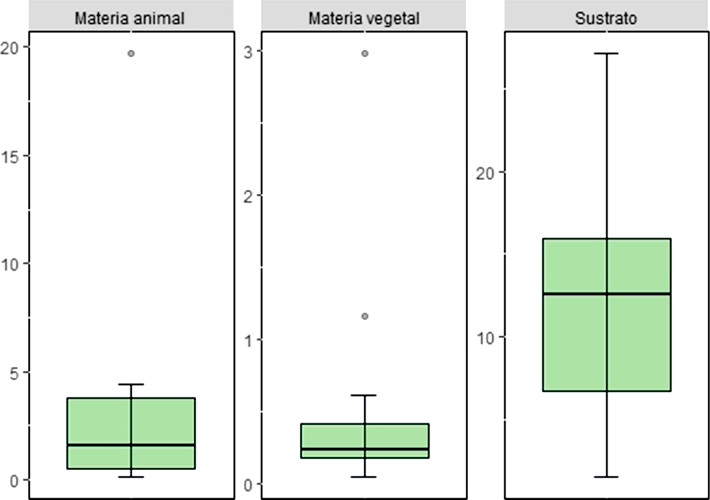Food habits of the southern lesser long-nosed armadillo (Dasypus septemcinctus hybridus) in Uruguay
DOI:
https://doi.org/10.31687/SaremNMS23.2.4Keywords:
ants, armadillos, diet, feces, Southern long nosed armadilloAbstract
The food habits of the Southern long-nosed armadillo are little known. We analyzed 15 feces obtained in 1997 in Florida, Uruguay. Feces were weighed and crumbled dry, and plant material, soil particles, and animal remains were separated. The beetles (Family Scarabaeidae) appeared in 100% of the feces, the Family Curculionidae in 93.3%, species of the Family Formicidae and the Order Orthoptera in 60%, and of the Family Carabidae in 53.3%. These results confirm the insectivorous-formicivore tendency of the species and show that when the southern long-nosed armadillo feeds on ants, it swallows significant amounts of soil.
References
Abba, A. M., & M. Superina. 2016. Dasypus hybridus (Cingulata: Dasypodidae). Mammalian Species 48:1–10. https://doi.org/10.1093/mspecies/sew001.
Abba, A. M., G. H. Cassini, & F. C. Galliari. 2011. Nuevos aportes a la historia natural de la mulita pampeana Dasypus hybridus (Mammalia, Dasypodidae). Iheringia, Série Zoologia 101:325–335.
Abba, A. M., & E. M. González. 2014. Dasypus hybridus. The IUCN Red List of Threatened Species 2014:e.T6288A47440329. https://doi.org/10.2305/IUCN.UK.2014-1.RLTS.T6288A47440329.en.
Abba, A. M., & S. F. Vizcaíno. 2011. Distribución de los armadillos (Xenarthra: Dasypodidae) en la provincia de Buenos Aires, Argentina. Mastozoología Neotropical 18:185–206.
Anacleto, T. C. S. 2006. Distribuição, dieta e efeitos das alterações antrópicas do Cerrado sobre os tatus. Tesis de Doctorado, Universidade Federal de Goiás, Goiânia, Brasil.
Anacleto, T. C. S., P. Smith, A. M. Abba, & M. Superina. 2014. Dasypus septemcinctus. The IUCN Red List of Threatened Species 2014:e.T6293A47441509. https://doi.org/10.2305/IUCN.UK.2014-1.RLTS.T6293A47441509.en.
Bentancourt, C., I. Scatoni, & E. Morelli. 2009. Insectos del Uruguay. Universidad de la República, Montevideo.
Bonato, V. 2002. Ecologia e história natural de tatus do Cerrado de Itirapina, São Paulo (Xenarthra, Dasypodidae). Tesis de Maestría, Universidade Estadual de Campinas, São Paulo, Brasil.
Feijó, A., B. D. Patterson, & P. Cordeiro-Estrela. 2018. Taxonomic revision of the long-nosed armadillos, Genus Dasypus Linnaeus, 1758 (Mammalia, Cingulata). PLoS ONE 13:e0195084. https://doi.org/10.1371/journal.pone.0195084.
Feijó, A. 2020. Dasypus septemcinctus (Cingulata: Dasypodidae). Mammalian Species, 52:1–9. https://doi.org/10.1093/mspecies/sez022.
Gallo, J. A., A. M. Abba, & L. Fasola. 2019. Armadillos as natural pests control? Food habits of five armadillo species in Argentina. Mastozoología Neotropical 26:117–127. https://doi.org/10.31687/saremMN.19.26.1.0.03.
Gibb, G. C., F. L. Condamine, M. Kuch, J. Enk, N. Moraes-Barros, M. Superina, & F. Delsuc. 2016. Shotgun mitogenomics provides a reference phylogenetic framework and timescale for living xenarthrans. Molecular Biology and Evolution 33:621–642. https://doi.org/10.1093/molbev/msv250.
González, E. M., A. Soutullo, & C. A. Altuna. 2001. The burrow of Dasypus hybridus (Cingulata: Dasypodidae). Acta Theriologica 46:53–59.
González, E. M., & J. A. Martínez-Lanfranco. 2010. Mamíferos de Uruguay. Guía de campo e introducción a su estudio y conservación. Banda Oriental, Vida Silvestre & MNHN, Montevideo.
González, E.M., J. A. Martínez, E. Juri, A. L. Rodales, G. Botto, & A. Soutullo. 2013. Mamíferos. Especies prioritarias para la conservación en Uruguay. Vertebrados, moluscos continentales y plantas vasculares. (Soutullo, A. et al., eds.) DINAMA/SNAP, Montevideo.
Parera, A., & F. Erize. 2002. Los mamíferos de la Argentina y la región austral de Sudamérica. Editorial El Ateneo, Buenos Aires.
Silva, K. F. M. 2006. Ecologia de uma população de tatu-galinha (Dasypus septemcinctus) no Cerrado do Brasil Central. Tesis de Mastría, Universidade de Brasilia, Brasilia, Brasil.
Vaz, V. C., R. T. Santori, A. M. Jansen, A. C. Delciellos, & P. S. D'Andrea. 2012. Notes on food habits of armadillos (Cingulata, Dasypodidae) and anteaters (Pilosa, Myrmecophagidae) at Serra Da Capivara National Park (Piauí State, Brazil). Edentata 13:84–89.
Zolessi, L. 1989. Catálogo sistemático de las especies de formícidos del Uruguay (Hymenoptera: Formicidae). Publicación Extra. Museo Nacional de Historia Natural / ROSTLAC, UNESCO, Montevideo.

Downloads
Published
How to Cite
Issue
Section
License
Copyright (c) 2023 Graziele D. Stumm , Jorge A. Gallo, Agustín M. Abba, Enrique M. González

This work is licensed under a Creative Commons Attribution-NonCommercial 4.0 International License.

